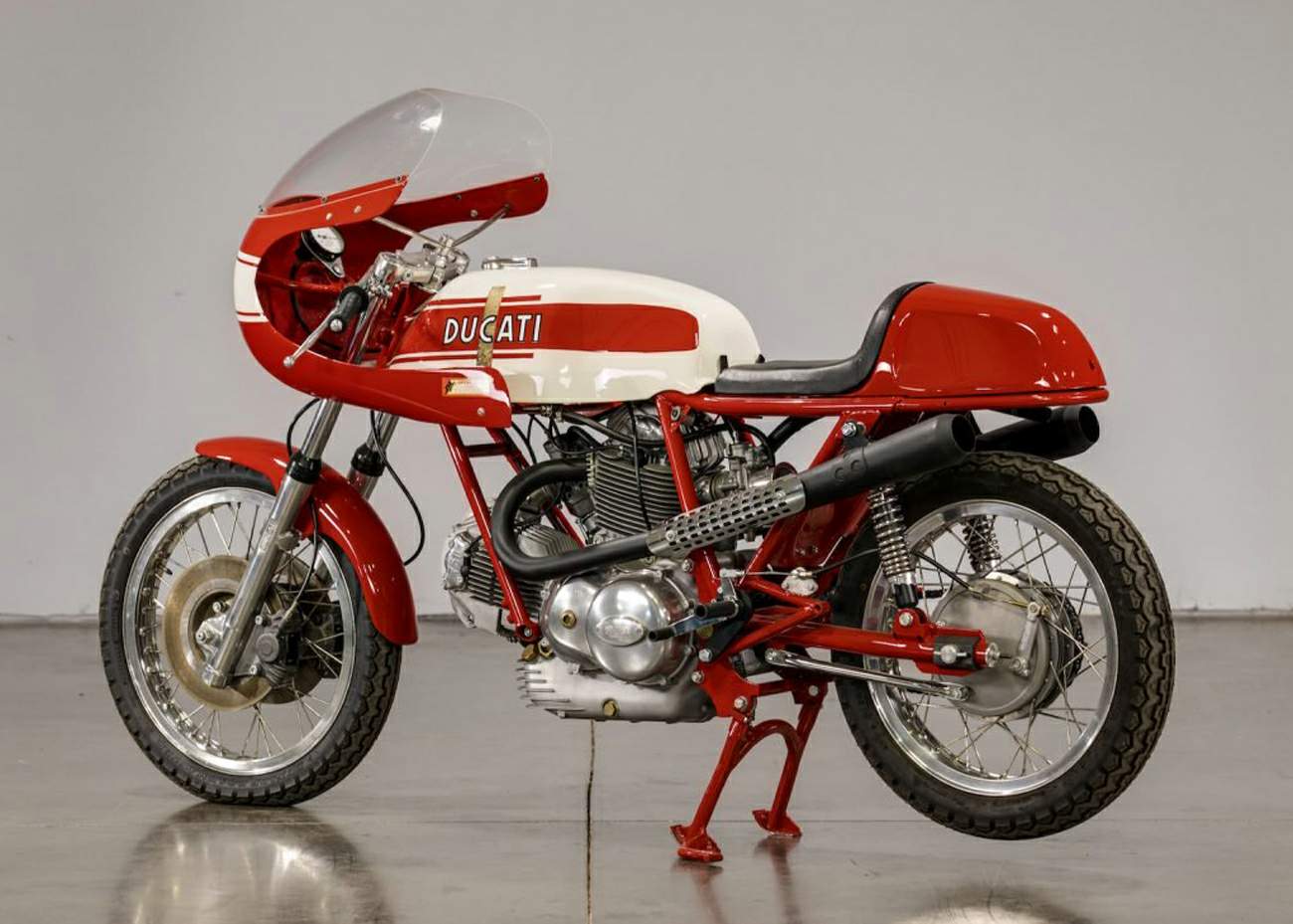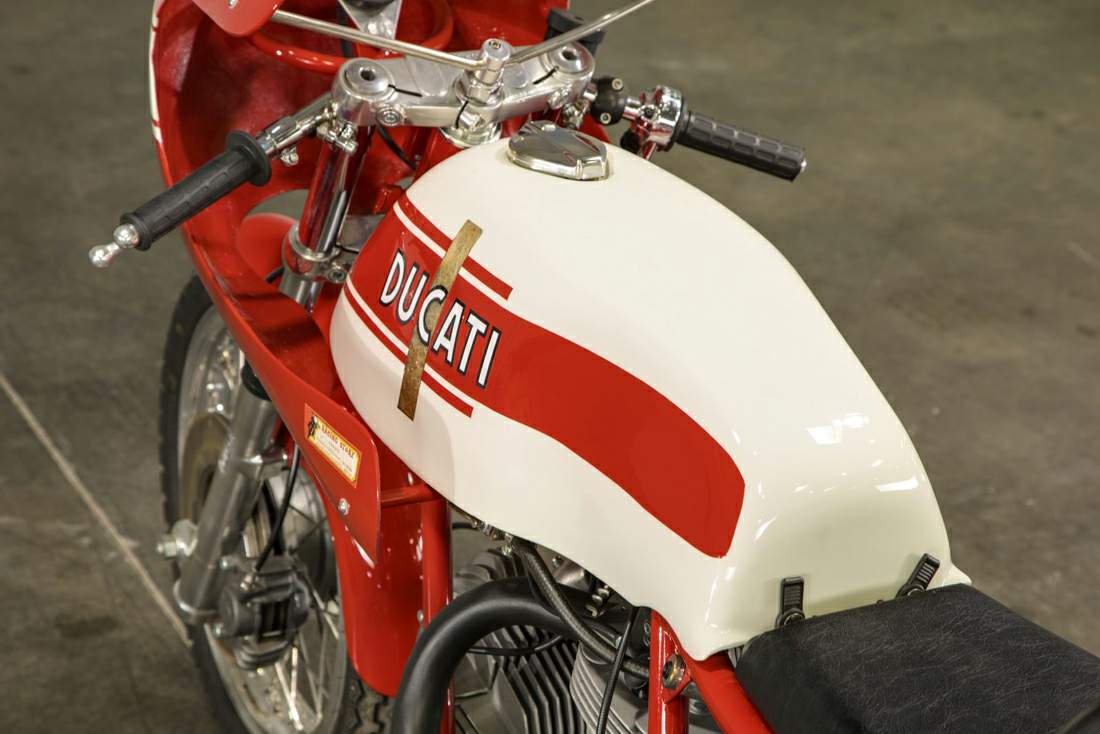
|
|
|
|
|
|
Classic Bikes
Custom Bikes
Individual
Racing Bikes AJP
AJS
Aprilia
Ariel
Avinton / Wakan
Bajaj
Benelli
Beta
Bimota
BMW
Brough Superior
BRP Cam-Am
BSA
Buell / EBR
Bultaco
Cagiva
Campagna
CCM
CF Moto
Combat Motors
Derbi
Deus
Ducati
Excelsior
GASGAS
Ghezzi Brian
Gilera
GIMA
Harley Davidson
Hero
Highland
Honda
Horex
Husaberg
Husqvarna
Hyosung
Indian
Jawa
Kawasaki
KTM
KYMCO
Laverda
Lazareth
Magni
Maico
Mash
Matchless
Mondial
Moto Guzzi
Moto Morini
MV Agusta
MZ / MuZ
NCR
Norton
NSU
Paton
Peugeot
Piaggio
Revival Cycles
Roland Sands
Royal Enfield
Sachs
Sherco
Sunbeam
Suzuki
SWM
SYM
Triumph
TVS
Ural
Velocette
Vespa
Victory
Vincent
VOR
Voxan
Vyrus
Walt Siegl
Walz
Wrenchmonkees
Wunderlich
XTR / Radical
Yamaha
Zero
Video
Technical
Complete Manufacturer List
|
Ducati 750 Sport
|
| . |
|
Make Model |
Ducati 750 Sport |
|
Year |
1972 - 73 |
|
Engine |
Four stroke, 90°“L”twin cylinder, SOHC, 2 valves per cylinder, bevel gear driven |
|
Capacity |
748 cc / 45.6 cu-in |
| Bore x Stroke | 80 x 74.4 mm |
| Compression Ratio | 9.3:1 |
|
Induction |
2 x Dell'Orto PHF 32A carburetors |
| Cooling System | Air cooled |
|
Spark Plugs |
Marelli CW 260T, Lodge 3HN |
|
Ignition |
Points and coil |
| Battery | Yuasa 12N-12A-4A-12V |
| Starting | Kick |
|
Max Power |
45.6 kW / 62 hp @ 8200 rpm |
|
Clutch |
Wet, multiplate |
|
Transmission |
5 Speed |
| Primary Drive Ratio | 2.448:1 (29/71) |
| Gear Ratios | 1st 2.237 / 2nd 1.562 / 3rd 1.203 / 4th 1.000 / 5th 0.887:1 |
| Final Drive Ratio | 2.250:1 (16/36) |
| Final Drive | Chain |
|
Frame |
Tubular steel, twin downtube |
|
Front Suspension |
38 mm Marzocchi fork |
|
Rear Suspension |
Dual shocks, Marzocchi 305 mm, 3-way adjustable |
|
Front Brakes |
Single 275 mm disc, Lockheed caliper |
|
Rear Brakes |
200 mm Drum |
|
Front Tyre |
3.25 - 19 |
|
Rear Tyre |
3.50 - 18 or 4.10 - 18 |
| Dimensions |
Length 2200 mm / 86.6 in Width 710 mm / 28.0 in Height 1070 mm / 42.1 in |
| Wheelbase | 1530 mm / 60.2 in |
| Seat Height | 780 mm / 30.7 in |
|
Dry Weight |
182 kg / 401 lbs |
|
Fuel Capacity |
17 Litres / 4.5 US gal / 3.7 Imp gal |
|
Top Speed |
210 km/h / 131 mph |
|
Colours |
Black frame, yellow and black |

The Ducati 750 Sport is an exceedingly rare motorcycle that sits squarely between its two more famous siblings – the Ducati 750 GT and the Ducati 750 Super Sport (SS). Put simply, the Ducati 750 Sport (also known as the 750S) was a higher-performance version of the slightly more consumer-friendly 750 GT.
The 750 Sport is slightly more powerful than the GT and it could be ordered
with a half fairing and twin front disc brakes if required – making it a popular
choice for privateer racers in Europe in the early 1970s.
The Ducati 750 L-Twin
The Ducati 750 Sport first appeared in 1972, it was the fastest and most powerful road-legal motorcycle ever built by Ducati up until that point, and it was designed to compete squarely with both the Japanese and the British.
Ducati was still relatively new to the superbike game in 1972, they had only produced their first L-twin a year earlier in 1971. Prior to this the company had made a name for themselves selling beautifully designed, smaller-capacity motorcycles.

The engine design followed somewhat in the footsteps of the V-twin used in the Vincent Black Shadow, in that Italian engineer Fabio Taglioni had taken two single cylinder barrels and heads and modified them to fit onto a newly designed crankcase – in much the same way that Phil Irving had done all those years earlier.
The genius of this design strategy is that you take proven, pre-existing heads and valve trains, as well as barrels, pistons, and connecting rods. This simplifies the process of designing a new engine considerably, and means you can use a pre-existing parts supply. Of course the actual design was modified somewhat, particularly the heat sink fins on the barrels of the front-facing cylinder, which were changed to make better use of the airflow coming from above the heads in the cylinder’s new orientation.
Despite its relative newness, the 748cc Ducati twin was an almost immediate success. Racing icon Paul Smart rode his Ducati 750 Imola Desmo to a hugely popular win at the 1972 Imola 200 with Bruno Spaggiari in second place on a matching Ducati. It’s difficult to describe how important this win was at the time, it helped to launch Ducati from a well-known maker of smaller-engined motorcycles to endurance race winning superbike manufacturers.

The production version of the 750 Imola Desmo was the Ducati 750 GT, it was fitted with a regular valve train rather than the desmodromic design used on the race bike for the sake of consumer-friendliness. The 750 GT produced 57 hp and proved popular with motorcyclists, helping to slow the Japanese invasion slightly, and establishing Ducati as a world-class builder of road-going superbikes.
The Ducati 750 Sport was designed to fill the gap between the Imola 200 winning 750 Imola Desmo and the 750 GT.
In order to squeeze a little more power out of the L-twin the compression ratio was increased and a pair of larger 32mm Dell’Orto PHF carburetors were fitted with no filters – just a wire mesh over the velocity stacks.
As a hat-tip to its performance intentions the 750 Sport was given clip-on handlebars and rear sets, buyers could also opt for a half fairing and twin front disc brakes. Most examples left the factory wearing bright yellow paint work, and all were fitted with side covers bearing the “750 Sport” branding.
With a total weight of 182 kilograms (401 lbs), 62 hp, and a top speed approaching 130 mph the model proved desirable – though Ducati didn’t build all that many of them as they tried to keep up with demand for the less expensive 750 GT.
Source silodrome.com
|
Any corrections or more information on these motorcycles will be kindly appreciated. |